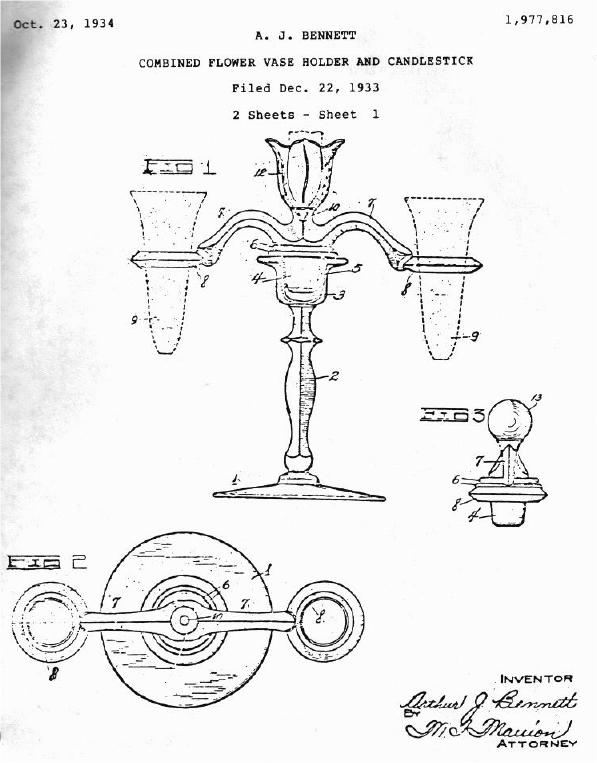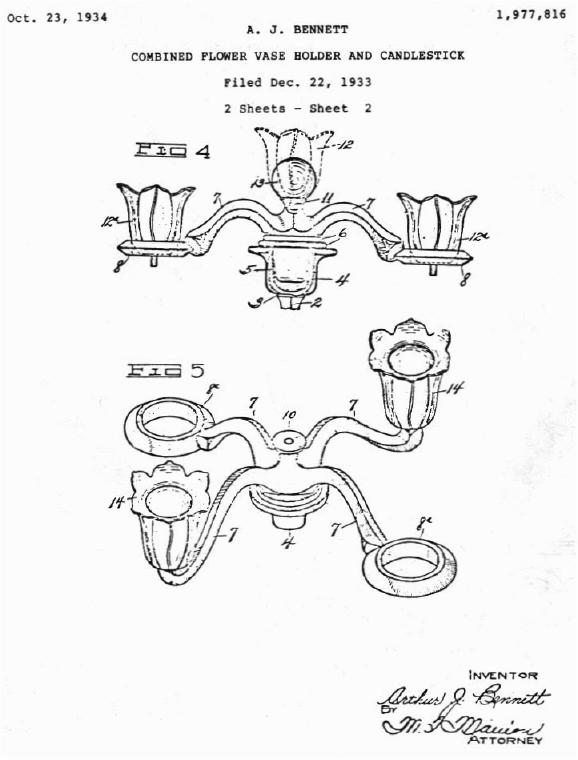Epergnes & Epergnettes, Part I
by Mark A.
Nye
Issue No. 222 - October 1991
An integral part of any Cambridge epergne is the arm that holds the flower vases. This arm may have a candle holder in its center or in lieu of a candleholder, a decorative knob. On December 22, 1933, Arthur James Bennett, Cambridge, Ohio, filed a patent application, serial number 703,564, for a "COMBINED FLOWER VASE HOLDER and CANDLESTICK." This item was Patented Oct. 23, 1934 and the Patent Number was 1,977,816. The patent drawings are at the end of the article.
The text of the application read as follows:
"This invention relates broadly to decorative articles for homes and more particularly to a combination flower vase holder and candlestick having candelabra characteristics.
The primary object of the invention is to provide a decorative article of the character mentioned which not only possesses a large degree of ornamentality, but additionally, has certain utilitarian properties in that the device is readily adapted, by reason of interchangeable features, to be easily converted into several and varied uses, each resulting in differing esthetic and optical effects.
Another object of the invention is to provide an article of the character mentioned which can be readily and conveniently used in association with the ordinary form of candlestick.
Further objects will be made apparent during the course of the following description, during which reference is made to the accompanying drawings, in which:
- Figure 1 is a side elevation of my invention associated with and supported by an ordinary candlestick;
- Figure 2 is a top plan view of the same with the centrally located tulip-shaped candle holder removed;
- Figure 3 is an end view of my invention detached and removed from the candlestick, an ornamental globe being substituted for the central candle holder shown in Fig. 1;
- Figure 4 is a side view of the invention and the well portion of a candlestick illustrating one adaptation of the invention, portions of said view being depicted in fragmentary section; and ...
- Figure 5 is a perspective view of a modified form of the invention.
Referring to said drawings, the reference numeral 1 designates the base of an ordinary candlestick the same having a vertical stem 2 upon the upper end of which is integrally formed the usual well 3.
Received with the well 3 is a male member 4, of such size and contour that it fits snugly within said well, although, if preferred an appropriate gasket 5 may be used to provide the desired tightness of a friction closure. The upper portion of said male member 4 is surmounted by a pair of superimposed circular beads 6, each of which has a rounded periphery, and the upper of which beads is of less diameter than the lower bead and has a flat top from which extend outwardly at diametrically opposite points horizontally disposed arms or branches 7 having an artistic compound curvature, each arm terminating at its outermost end in the formation of a ring 8. As shown in Fig. 1 of the drawings, each of said rings is adapted to removably receive and support a flower vase 9, perfume bottle, or any similar article having upwardly and outwardly inclined sides or having a flared upper end.
A small circular depression or recess 10 is provided in vertical axial alignment with the well 3 at the inner junction of the arms 7, this recess being adapted to frictionally encompass a stud or pin 11 formed on the lower end of an ornamental candle holder 12, as shown in Fig. 1. Other ornamental figures, symbols, designs or shapes may, however, be substituted for the candle holder 12, as, for instance, the globe 13 shown in Figs. 3 and 4 of the drawings.
As shown in Figure 4 of the drawings, removable ornamental candle holders 12a, substantially similar to the centrally located candle holder 12, may be received in and supported by the rings 8 to form an artistic and graceful candelabra effect.
The structure depicted in Figure 5 of the drawing reveals a modified form of the invention wherein four equally spaced arms branch out radially from the central portion of the device, two of the diametrically opposite arms at their outer termination having permanently attracted thereto upwardly extending candle holder 14, while the other two arms terminate at their outer ends in the formation of the supporting rings 8a.
Manifestly, from the above description it will be observed that varied combinations may be conveniently obtained by the mere interchanging of features of the device so as to utilize the same to blend with differing decorative schemes. Furthermore, the use of bobeches and pendant light reflecting prisms at the proper locations on the device will lend additional ornamentality of the device when the latter are deemed desirable.
While I have herein described the device as being made to be used in association with a candlestick, it is, of course, obvious that the base, the stem and the horizontal radiating arms may be made in one-piece, as in glass.
What is claimed is ...
In a device of the type set forth, an integral supporting member having a depending central male member formed to be removably received in the well of a candlestick and having a socket formed therein surrounded by an upwardly facing seat located above and in alinement with the male member, article holders integral with the supporting member and having open centers, and ornamental articles for interchangeable use with the socket and the article holders having depending studs each receivable in the socket and having bottom portions engaged with the seat to form an ornamental top for the supporting member and having portions which are receivable through the open centers of the holders and are supported from their peripheries thereby.
Arthur James Bennett


